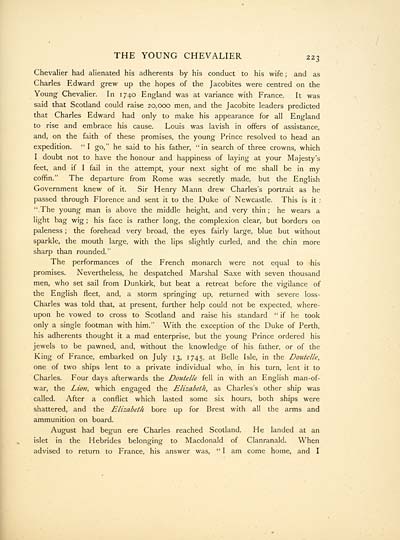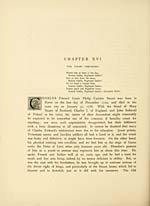Stuarts
(295) Page 223
Download files
Complete book:
Individual page:
Thumbnail gallery: Grid view | List view

THE YOUNG CHEVALIER 223
Chevalier had alienated his adherents by his conduct to his wife ; and as
Charles Edward grew up the hopes of the Jacobites were centred on the
Young Chevalier. In 1740 England was at variance with France. It was
said that Scotland could raise 20,000 men, and the Jacobite leaders predicted
that Charles Edward had only to make his appearance for all England
to rise and embrace his cause. Louis was lavish in offers of assistance,
and, on the faith of these promises, the young Prince resolved to head an
expedition. "I go," he said to his father, "in search of three crowns, which
I doubt not to have the honour and happiness of laying at your Majesty's
feet, and if I fail in the attempt, your next sight of me shall be in my
coffin." The departure from Rome was secretly made, but the English
Government knew of it. Sir Henry Mann drew Charles's portrait as he
passed through Florence and sent it to the Duke of Newcastle. This is it :
" The young man is above the middle height, and very thin ; he wears a
light bag wig ; his face is rather long, the complexion clear, but borders on
paleness ; the forehead very broad, the eyes fairly large, blue but without
sparkle, the mouth large, with the lips slightly curled, and the chin more
sharp than rounded."
The performances of the French monarch were not equal to his
promises. Nevertheless, he despatched Marshal Saxe with seven thousand
men, who set sail from Dunkirk, but beat a retreat before the vigilance of
the English fleet, and, a storm springing up, returned with severe loss-
Charles was told that, at present, further help could not be expected, where-
upon he vowed to cross to Scotland and raise his standard "if he took
only a single footman with him." With the exception of the Duke of Perth,
his adherents thought it a mad enterprise, but the young Prince ordered his
jewels to be pawned, and, without the knowledge of his father, or of the
King of France, embarked on July 13, 1745, at Belle Isle, in the Doutelle,
one of two ships lent to a private individual who, in his turn, lent it to
Charles. Four days afterwards the Doutelle fell in with an English man-of-
war, the Lion, which engaged the Elizabeth, as Charles's other ship was
called. After a conflict which lasted some six hours, both ships were
shattered, and the Elizabeth bore up for Brest with all the arms and
ammunition on board.
August had begun ere Charles reached Scotland. He landed at an
islet in the Hebrides belonging to Macdonald of Clanranald. When
advised to return to France, his answer was, " I am come home, and I
Chevalier had alienated his adherents by his conduct to his wife ; and as
Charles Edward grew up the hopes of the Jacobites were centred on the
Young Chevalier. In 1740 England was at variance with France. It was
said that Scotland could raise 20,000 men, and the Jacobite leaders predicted
that Charles Edward had only to make his appearance for all England
to rise and embrace his cause. Louis was lavish in offers of assistance,
and, on the faith of these promises, the young Prince resolved to head an
expedition. "I go," he said to his father, "in search of three crowns, which
I doubt not to have the honour and happiness of laying at your Majesty's
feet, and if I fail in the attempt, your next sight of me shall be in my
coffin." The departure from Rome was secretly made, but the English
Government knew of it. Sir Henry Mann drew Charles's portrait as he
passed through Florence and sent it to the Duke of Newcastle. This is it :
" The young man is above the middle height, and very thin ; he wears a
light bag wig ; his face is rather long, the complexion clear, but borders on
paleness ; the forehead very broad, the eyes fairly large, blue but without
sparkle, the mouth large, with the lips slightly curled, and the chin more
sharp than rounded."
The performances of the French monarch were not equal to his
promises. Nevertheless, he despatched Marshal Saxe with seven thousand
men, who set sail from Dunkirk, but beat a retreat before the vigilance of
the English fleet, and, a storm springing up, returned with severe loss-
Charles was told that, at present, further help could not be expected, where-
upon he vowed to cross to Scotland and raise his standard "if he took
only a single footman with him." With the exception of the Duke of Perth,
his adherents thought it a mad enterprise, but the young Prince ordered his
jewels to be pawned, and, without the knowledge of his father, or of the
King of France, embarked on July 13, 1745, at Belle Isle, in the Doutelle,
one of two ships lent to a private individual who, in his turn, lent it to
Charles. Four days afterwards the Doutelle fell in with an English man-of-
war, the Lion, which engaged the Elizabeth, as Charles's other ship was
called. After a conflict which lasted some six hours, both ships were
shattered, and the Elizabeth bore up for Brest with all the arms and
ammunition on board.
August had begun ere Charles reached Scotland. He landed at an
islet in the Hebrides belonging to Macdonald of Clanranald. When
advised to return to France, his answer was, " I am come home, and I
Set display mode to:
![]() Universal Viewer |
Universal Viewer | ![]() Mirador |
Large image | Transcription
Mirador |
Large image | Transcription
Images and transcriptions on this page, including medium image downloads, may be used under the Creative Commons Attribution 4.0 International Licence unless otherwise stated. ![]()
| Histories of Scottish families > Stuarts > (295) Page 223 |
|---|
| Permanent URL | https://digital.nls.uk/95242591 |
|---|
| Description | A selection of almost 400 printed items relating to the history of Scottish families, mostly dating from the 19th and early 20th centuries. Includes memoirs, genealogies and clan histories, with a few produced by emigrant families. The earliest family history goes back to AD 916. |
|---|

